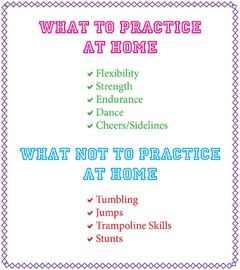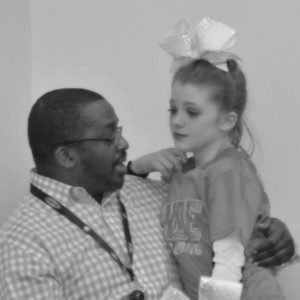Cheer Safety: Practicing at Home
 You’re so excited that you’re going to be on a cheerleading team that you can’t go anywhere without throwing your leg up in a heel stretch or turning cartwheels! When cheerleading runs in your veins, you can’t help but want to bust out your best moves wherever you go. Since you can’t be in the gym 24/7, practicing at home is something you want and need to do.
You’re so excited that you’re going to be on a cheerleading team that you can’t go anywhere without throwing your leg up in a heel stretch or turning cartwheels! When cheerleading runs in your veins, you can’t help but want to bust out your best moves wherever you go. Since you can’t be in the gym 24/7, practicing at home is something you want and need to do.
As a cheer coach, I find that a good portion of cheer injuries and bad habits come from practicing at home. I think practicing at home is a good idea, provided that you only do certain things and you do them safely.
What to Practice at Home
Flexibility, strength and endurance are important to every cheerleader, whether you are a base, a flyer or a back spot. Everyone has to jump, tumble, dance, and stunt, and those things take muscle. You also have a long routine to perform and/or a long game to cheer for so you must have endurance. It is ALWAYS okay to work on your strength, flexibility and endurance at home! You can get some weights, work out to a DVD, hop on the treadmill or run around your neighborhood. By doing these things consistently at home, you’ll find that all of your skills will become easier and you will gain new tricks quickly.
Flyers must be extremely flexible so practicing balance and flexibility is also important. You can practice heel stretches, scorpions, bow-and-arrows and needles with the help of a belt. Stand next to a wall. Put the belt around your shoe and then use the strap part to pull your leg up into position while using the wall for balance. Make sure you have good form with a straight standing leg!
You can also practice your cheers and dance at home. It’s a good idea to get a copy of your performance music and write down the words to all the cheers and sidelines. Have someone videotape the routine for you, and make sure they video from the BACK so that you don’t learn the moves the opposite way! Practicing in front of a mirror or videotaping yourself is a great way to see what you need to improve upon.
 Whenever you’re practicing at home, make sure you have a clear, safe place to do so. Move all furniture out of the way and make sure there isn’t anything you can trip over. Tell your parents so that they can keep younger siblings out of the way so you don’t end up kicking them!
Whenever you’re practicing at home, make sure you have a clear, safe place to do so. Move all furniture out of the way and make sure there isn’t anything you can trip over. Tell your parents so that they can keep younger siblings out of the way so you don’t end up kicking them!
Visualizing your moves in your head is also another great way to practice! Just don’t do it during class, teachers don’t like that much!
What NOT to Practice At Home
I always tell my students not to tumble at home! Most of the at-home injuries come from attempting a skill that you weren’t ready for or accidentally hitting furniture or walls.
When you practice a skill incorrectly, the mistake becomes part of the skill. It is SO HARD to unlearn a bad habit! It is actually harder to fix a skill than it is to learn it from scratch. Most bad habits come from practicing at home where there is no coach to correct you. Instead of moving yourself ahead, you may set yourself back. When you do a skill incorrectly, it prevents you from learning the next skill or adding on to it. For example, an incorrect back handspring means that you will have a lot of trouble doing more than one in a row, or adding a back tuck to the end. Save your tumbling for the gym under the supervision of your coach.
The bane of my existence is the trampoline. UGH! As a coach I can easily tell which kids have trampolines at home, and I know they will most likely need to unlearn many bad habits. The only thing a trampoline is good for is learning how to perform on a trampoline. We can’t drag a trampoline out on the mat for you to do your back tuck! Trampolines can be used sparingly to learn things like body position in aerial skills and jumps but must not be overused. A trampoline gives you the bounce; it doesn’t teach you to generate the power yourself. It also throws off the timing of your skills because everything on a trampoline is slower because you have to wait for the surface to rebound you up. Back handsprings on the trampoline are the worst because the tumbler tends to want to double bounce the takeoff, they are high and the tumbler must learn bad habits in order to compensate for the extra height a trampoline gives. I can always spot a back handspring learned on a trampoline. Can a trampoline be used in the gym to learn skills? Absolutely. But the coach will make sure that they are not overused and that no bad habits are formed. Jumps on the trampoline are fine for learning position, but jumping on a trampoline and doing it on the floor are very different. Do yourself a favor and don’t practice tumbling on your trampoline.
Finally, do not stunt with your friends or teammates in your back yard. Stunting is dangerous so it should only be attempted in the gym with a trained coach present. Even small stunts can result in a concussion or a broken arm. One thing I have noticed is when cheerleaders stunt for fun in their yards, they tend to goof off and laugh a lot. This results in each cheerleader not paying close attention to safety. My advice is to keep stunting for practice, games and competitions.
Practicing at home can help you become the best cheerleader you can be! If you’re not sure if you should be doing something at home, talk to your coach. Happy practicing!
http://www.heartofcheer.com/cheerleaders/cheer-safety-practicing-home/http://www.heartofcheer.com/wp-content/uploads/2014/11/Practice.jpeghttp://www.heartofcheer.com/wp-content/uploads/2014/11/Practice-150x150.jpegBlogCheerleaderscheer safety,cheerleading,practicing at home



